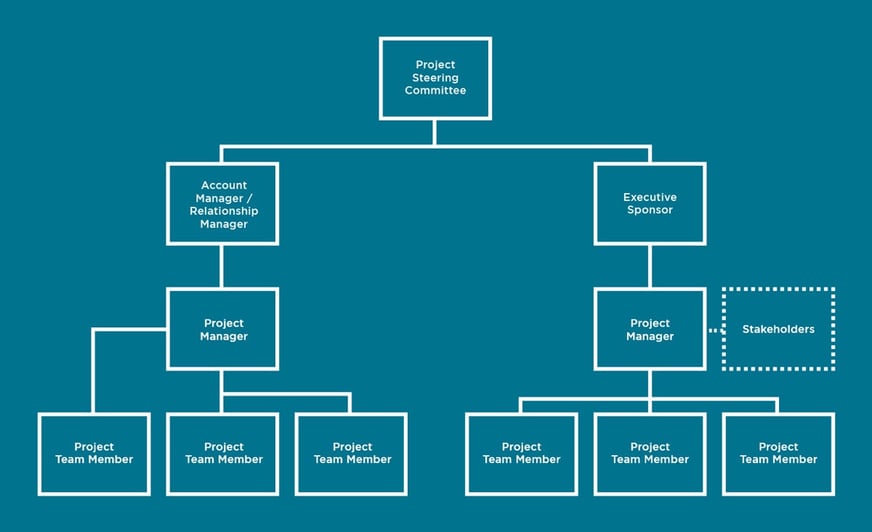
When you begin an eCommerce project, you typically hire a team based on their experience and expertise. But who all is involved with a project, and where does your team fit in? Get ready for some handshakes, because it’s time to meet your project team.

The Steering Committee is made up of senior managers from key business units and departments involved in the project. The Committee initially builds consensus throughout the organization and then, once the project in underway, ensures that the project continues to meet the set vision, goals, and objectives. Throughout the project they will also meet to resolve any necessary issues, review and approve scope or schedule changes, and provide general direction and leadership for the project.
This is an executive-level team member who has the ultimate authority over the project. They allocate funding, fulfill client-side project resources, and provide executive-level direction when needed. The Executive Sponsor is the vocal and visible champion of the project both within the organization and for the consulting team.
The Project Sponsor is ultimately responsible for the success of the project. They have knowledge of the internal business case and key objectives of the project. They will receive regular project updates, provide clarity to the project vision, offer leadership, and remove business-related barriers to the progress of the project. Depending on the size of the project, the Project Sponsor and the Executive Sponsor roles can be filled by the same person.
In the case of a larger endeavor with multiple projects going on simultaneously, the Program Manager oversees and coordinates the related projects to ensure their success. While this role is very influential over all Project Teams, they do not manage the individual people involved. In larger projects, a Program Manager is needed on both the client and consultant sides.
As with any business endeavor, these are the people that have an interest in the outcome of the project. While they are typically client team members, some projects can include Stakeholders who are external to the company, including investors, customers, and suppliers. Responsibilities vary, but Stakeholders might confirm project changes or grant approval to proceed to the next phase of the project.
SMEs are customers who participate in defining requirements for the project as representatives of customer needs. They typically have expert knowledge of a specific function, technology, or business process, and they can bring information about the project back to the customer community. These individuals often take place in User Acceptance Testing of the new site at the end of the project. Typically, the needed Subject Matter Experts will have knowledge of:
This executive-level person on the consultant side is responsible for managing the customer relationship as a whole across the entire project. They are responsible for ensuring that all of the commitments made by both the Consultant Team and the Client Team are completed.
This is a purely strategic role and serves to make sure the consultants understand the goals and objectives of the client. An Account Manager analyzes and recommends new business opportunities to maximize client satisfaction, keeps track of developments and trends in the industry, and is the counterpart to the client’s Executive Sponsor.
The Project Manager is the liaison who will establish project timelines and milestones, and will facilitate any required project communication. Depending on the size of the project, there may be a Project Manager on the client side as well as on the consulting side.
The Project Manager is responsible for managing the day-to-day activities of the project and is ultimately responsible for ensuring that the project is delivered on budget, on schedule, and within scope. Tasks the Project Manger is responsible for include:
The Project Team is made up of those individuals who are responsible for planning and executing the project. They can be full- or part-time, technical or functional. The size of the Project Team varies with the complexity or size of a project. Project Team Members are responsible for completing tasks related to their expertise as well as potentially producing deliverables according to the project timeline. Project Team members and their responsibilities include:
Obviously each project is different and not all roles are needed for every project, but filling out these roles will help the Project Manager define project responsibilities from the start. This provides a solid basis for accurate project planning and reporting, and ultimately helps deliver the eCommerce site of your dreams.
Lorem ipsum dolor sit amet, consectetur adipiscing elit

For the past two decades, we've made it our business to help you work smarter. From commerce challenges to ERP customizations, we support the power of your big ideas by helping you work more strategically, more intuitively, and more efficiently.
2658 Scranton Road, Suite 3
Cleveland, Ohio 44113
216.369.3600
No Comments Yet
Let us know what you think